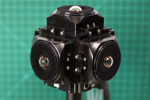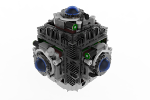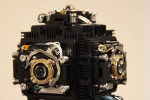The compact size and high resolution of the monocentric lenses, coupled with a flexible backend electronics architecture, allows the sensor heads of the standard DFC Monocentric Camera to be reconfigured into an ultra-compact, high-resolution panoramic system. Five apertures image simultaneously, with the data being sent over fiber-optic cables to remote processing electronics where the individual images are stitched into a single image or video.
Fiber-optic Sensor Link
The panoramic system is kept compact by remoting the FPGA, memory, and processing electronics via the fiber-optic cables. At the sensor side, the remote link is implemented with an interface board that plugs into the standard sensor board used in the standalone systems. These interface boards are mounted onto a central core heatsink that also provides the main supporting structure for the head.
PMAST Head Design
By design, the panoramic system shares many pieces in-common with the standalone cameras. The sensors, fiber bundles, focus mechanisms, and front covers are all interchangeable. There is another heatsinking/mounting piece used on the PMAST to connect each of the apertures to each other and ensure proper pointing of each, and there is also a water-cooled heat exchanger at the bottom that allows the system to be used in warmer environments.
Demo Panoramic Imagery
Panoramic Still in Atrium at UCSD

Panoramic Still Behind DFC

Panoramic Video at UCSD

Panoramic Video Behind DFC

Earlier SCENICC Work:
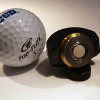
Early Research
During the early phase of the program UCSD and DFC produced several prototype systems while exploring the monocentric lens architecture and the potential of fiber-coupled image planes. This includes a 30 megapixel, 6 sensor system that proved the potential of multiple-sensor fiber-coupled imaging systems.
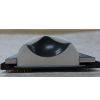
Tapered Fiber Bundle Imager
To reduce the complexity and cost of the original multi-sensor approach, a new approach for large curved focal planes was developed. Using a single large fiber bundle and a single high-resolution sensor, this research paved the way for the development of the DFC Monocentric Camera system.

